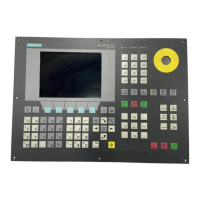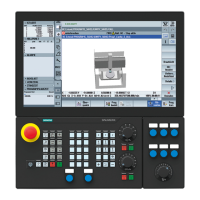V1: Feedrates
17.2 Path feedrate F
Basic Functions
1374 Function Manual, 09/2011, 6FC5397-0BP40-2BA0
Master spindle switchover with G96, G961
If the master spindle is switched over when G96, G961 are active, the speed of the former master spindle is
retained. This corresponds to a transition from G96 to G97. The master spindle newly defined with SETMS
executes the "Constant cutting rate" function generated in this way.
Interrupts
Constant cutting rate G96, G961, G962
• If no F value is programmed, alarm 10860 "No feedrate programmed" is output. The alarm is not generated
with G0 blocks.
• Alarm 14800 "Programmed path velocity smaller than or equal to zero" is output while programming a
negative path velocity.
• If, with an active G96, G961 or G962, no transverse axis is defined in the machine data:
MD20100 $MC_DIAMETER_AX_DEF (geometry axis with transverse axis function)
, alarm 10870 "No transverse axis defined" is issued.
• If a negative maximum spindle speed is programmed with the LIMS program command when G96, G961 are
active, alarm 14820 "Negative maximum spindle speed programmed for G96, G961" is output.
• If no constant cutting rate is programmed when G96, G961 is selected for the first time, alarm 10900 "No S
value programmed for constant cutting rate" is output.
17.2.4 Feedrate with G33, G34, G35 (thread cutting)
17.2.4.1 General
Application of G33
The function G33 can be used to machine threads with constant lead of the following type:
References:
/PA/ Programming Guide, Fundamentals
/PAZ/ Programming Guide, Cycles
Speed S, feedrate F, thread lead
A revolutional feedrate [mm/revolution] is used for G33 threads. The revolutional feedrate is defined by
programming the thread lead increase [mm/revolution].
The speed of the axes for the thread length is calculated from the programmed spindle speed S and the thread
lead.
Feedrate F [mm/min] = speed S [rev/min] * thread lead [mm/rev]

